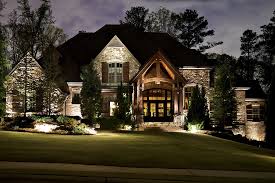Landscape lighting is something that can be enjoyed in all seasons, no matter if it’s snowing inside or is it a warm summer night. Outdoor landscape lighting can not only help you save yourself from stumbling or tripping, but it can also enhance your backyard’s image at night and improve its visual appeal.

Parameters of Landscape Lighting
There are many home-owners who believe that they have the art of landscape lighting. This blog is to help all those artists find their vision by letting them know some crucial things and designing parameters of landscape lighting.
1. Perspective
For landscape lighting designers, it is not a backyard but a three-dimensional canvas. They believe that the backyards and homes are open from many sides to people’s vision and so should be a visual treat from all sides. Due to this, the designers consider all the nooks and corners while artfully plotting out the landscape lighting plant. Designers develop the skill of not missing out on a single place to highlight with years of experience.
2. Depth
Depth is the difference between good landscape lighting and great landscape lighting. Depth decides the visual periphery of the participant and guides their eyes through the symphonies of landscape elements and structures. The depth decides:
- The focus point of your landscape
- Proper transitions between the elements
- Highlighted visual areas
3. Quality and Direction
There are different sets of lighting for different elements like driveways, plants, and trees. Selecting the right one decides the quality of your landscape lighting. It also helps to set a mood for your outdoors.
There are several directions that landscape lighting designers generally work with to develop a certain mood. Following are a few directional lighting techniques with the mood it helps to develop.
- Up Lighting- for uplifting, grand, spooky, or dramatic effect
- Down Lighting- for a more romantic, natural, mellow, and subdued effect
- Front Lighting- for flattening or revealing effect
- Back Lighting- for a more ethereal, mysterious, and understated effect
4. Focal Points
You cannot highlight everything or else it will just look like one big shiny mess of light. You need to have set focal points that you wish to highlight. These elements or structures should be chosen before beginning with the landscape lighting. Generally, to achieve this, designers play with different lights and techniques to feature the best of your backyard and home.
5. Balance and Symmetry
Balance and symmetry are the base of our universe and life on Earth. There are things that we still do not know about the universe but it still looks beautiful and we feel that balance and symmetry have a lot to do with it. We do not know who has developed such beautiful symmetry but we can surely help your home to achieve symmetry and balance while lighting for your home. Landscape lighting designers try to strike a balance between the different areas to be highlighted such that the whole lighting comes off as a visual harmony for your eyes.
6. Cohesion
A design is not complete if it is not cohesive. One cannot think about a few elements and think that their home will shine through. It is a comprehensive approach to controlling the lights and helping the home to form a complete picture-perfect lighting landscape.
Feel Like You Need a Professional?
These are the basics of landscape lighting and can surely make you feel overwhelmed if you do not belong to the designing background. We feel that landscape lighting is like an art so you should hire professional artists to work on your outdoor lighting installation project. Thus, get Land-con for your project! Call us at 416.504.5263 or drop us an email at info@landcon.ca to learn more about our services. Get in touch today for a free consultation!






